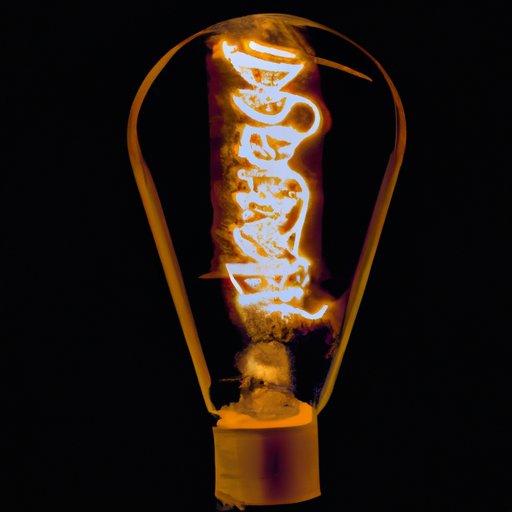Introduction
The invention of the lightbulb is one of the most important achievements of the 19th century. Although it is often credited to a single inventor, Thomas Edison, the development of this revolutionary technology was the result of multiple inventors over many years. This article looks at the history of the lightbulb and the role played by Edison in its invention. It also explores the changes that have been made to the design since then and the impact this has had on modern society.
Historical Timeline of Development
Electric lighting was first experimented with during the early 1800s. Humphry Davy, an English scientist, created the first electric arc lamp in 1809. However, this lamp was too bright for indoor use and could not be dimmed. Over the next few decades, other inventors continued to work on electric lighting. In 1840, British inventor Warren de la Rue created an incandescent lamp, which used a platinum filament to produce light, but this was too expensive for widespread use.
In 1878, Thomas Edison began working on a new design for an electric lamp. He eventually developed a bulb that used a carbonized bamboo filament. This filament was more durable than other materials and allowed for longer-lasting bulbs. Edison patented his invention in January 1880 and the first commercially successful electric lamps were sold shortly afterwards.
Edison’s design revolutionized the world. It enabled people to stay up late into the night, as well as making factories, businesses, and homes more productive. The invention of the lightbulb also sparked a wave of innovation in the electrical industry.
Comparison Between Edison’s Design and Modern Lightbulbs
Edison’s original design for the lightbulb has undergone several changes since then. The carbonized bamboo filament has been replaced with tungsten and other materials, which are more efficient and last longer. Additionally, the shape of the bulb has changed from the traditional pear shape to the more modern spiral design.
Modern lightbulbs also feature new technologies such as LED and fluorescent lights. These bulbs are much more energy efficient than traditional incandescent bulbs and can last up to 25 times longer. Additionally, LED bulbs can be designed to produce different colors and shapes.
Impact of 19th Century Technology on Today’s Society
The invention of the lightbulb had a huge impact on the way people lived in the 19th century. It enabled people to work and study after dark, allowing them to make better use of their time. Additionally, the lightbulb enabled factories to operate around the clock, increasing production and leading to greater economic growth.
Today, the effects of 19th century technology are still evident in modern society. Electric lighting is used in almost every aspect of life, from our homes and workplaces to public spaces. Additionally, the invention of the lightbulb has enabled us to explore new technologies, such as computers and smartphones, which rely on electricity to function.
Changes in Energy Usage Since the Invention of the Lightbulb
Before the invention of the lightbulb, energy usage was limited to candles, oil lamps, and gas lighting. These sources of light were inefficient and expensive, resulting in high energy costs. The invention of the lightbulb revolutionized the way people used energy. It enabled people to use electricity in their homes and businesses, reducing their energy costs.
Since then, there have been significant changes in the way we use energy. With the introduction of more efficient bulbs and alternative energy sources, such as solar and wind power, energy consumption has decreased significantly. Additionally, advances in technology have enabled us to create smart homes, which are able to monitor and adjust energy usage automatically. This has resulted in even greater energy savings.
Patent Wars After Edison’s Invention
After Edison’s invention of the lightbulb, there were numerous legal battles between different inventors. Edison and his competitors fought over the rights to the patent for the lightbulb, resulting in a series of lawsuits. Eventually, the courts ruled in favor of Edison, granting him the exclusive rights to the patent.
These patent wars had a lasting effect on the innovation of the lightbulb. They discouraged future inventors from creating new designs, as they were afraid of being sued. This led to a stagnation in the development of the lightbulb, and it wasn’t until the mid-20th century that new designs started to emerge.
Conclusion
The invention of the lightbulb is one of the most significant achievements of the 19th century. Thomas Edison’s design revolutionized the world, enabling people to stay up late into the night and sparking a wave of innovation in the electrical industry. His invention also had a lasting impact on modern society, as electric lighting is now used in almost every aspect of life. Additionally, the invention of the lightbulb has enabled us to save energy, which has resulted in lower energy costs.
The legacy of Edison’s invention lives on today. His work has inspired countless inventors and engineers to create new designs for the lightbulb. Additionally, the patent wars that followed his invention have shaped the way we innovate today. As we continue to develop new technologies, we must remember the importance of Edison’s invention and its impact on the world.
(Note: Is this article not meeting your expectations? Do you have knowledge or insights to share? Unlock new opportunities and expand your reach by joining our authors team. Click Registration to join us and share your expertise with our readers.)
